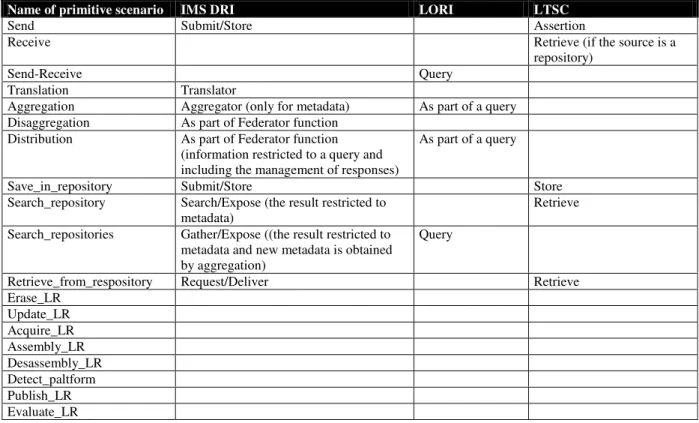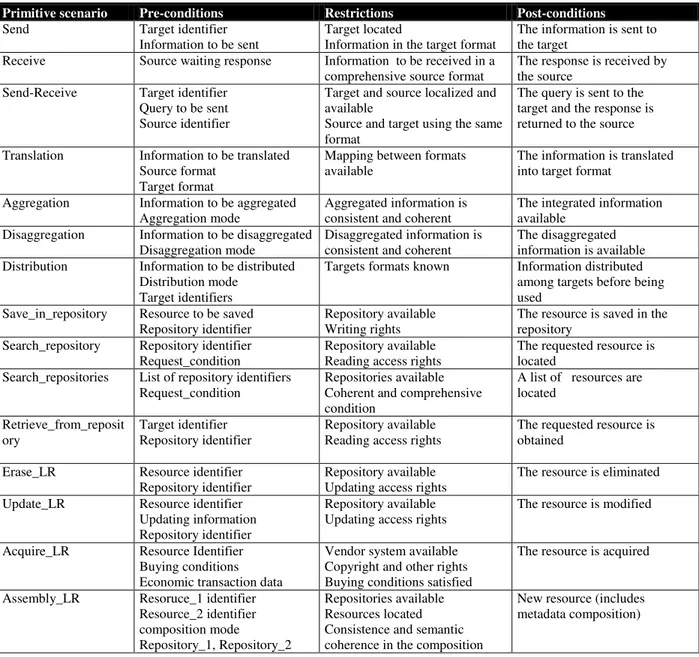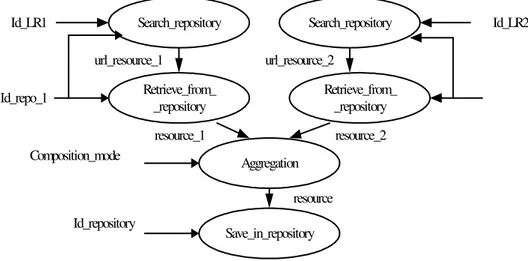A catalogue of Primitive Scenario Types : The First Step to the Automation of Learning Scenarios
Texto completo
(2) Technology – Learning Technology Systems Architecture (LTSA) (LTSC, 01) provides a framework with the aim to facilitate the comprehension of systems such as LMS, their subsystems and the interaction with other related systems and it also proposes an architecture. Consequently, these specifications have been used as a starting point to determine the basic scenarios that can be considered primitive in order to construct the catalogue that we want to create. The paper is organized in six sections. After this introduction, the second section introduces the subject matter; the third compares the scenariotypes proposed by other types of implementation and standards. The next two sections, based on those, propose a catalogue of primitive scenario-types to cover basic functionalities in the boundaries of LMS and how it is possible to join them to create new scenario-types. The last section presents some conclusions and future work.. Basic concepts related to scenarios Fist of all, we have to define what we understand by scenario, scenario-type and other related concepts. A scenario-type or a specification of scenario is consistent description of the behaviour of the entities involved in a process and the different states of the system in order to achieve an objective. Thus, a scenario would be an instance of scenario-type and it could be concreted by a use case. Several entities take part in a scenario, each of them has a role and they interact with each other. These entities will be called actors and the instance of an actor in a concrete scenario from now on will be called actor-role. As the LMS environment is a distributed environment, communication among the actors will be established using flow messages. A message-type can be considered as the description of an operation in which the kind of communication among actors, the structure of the message that will be sent and the direction of the shipment are established. The message, in consequence, will be an instance of the message-type. Since several actors take part in a scenario and all of them collaborate in the achievement of the objective, there are a set of processes where these actors take part and a protocol to define the way in which the message interchange is going to be carried out. If there is a one only process that is in charge of dictating the rules that guide the communication process among all actors, we say that the orchestration specification is necessary, while if the responsibility is shared among several processes, a choreography specification is required.. Scenario-Types in other specifications and standards In this section, the contributions of those specifications mentioned before are exposed, since through comparing them, a more global vision is produced and it has helped us to obtain a minimum set of scenarios type to build our catalogue. In IMS DRI (IMS, 03) four actors are proposed (Creator, Learner, Infoseaker, Agent) and some scenario type (Aggregator, Federator, Translator) in order to resolve the problem of multiple metadata representation and different access methods. It also proposes pairs of functions (Search/Expose, Gather/Expose, Submit/Store) to search, access, store and retrieve metadata or data in the repository. In contrast, LORI (CEN, 05) only considers two actors; the source (SQI source) and the target (SQI target) and a query scenario that can be implemented in an asynchronous or synchronous way. Furthermore, LORI focuses on queries more than on interchange of data among repositories. It seems that LORI and IMS DRI are complementing them. On the other hand, the IEEE LTSC specification (LTSC, 01) offers a wider perspective. It considers not only repository issues, since it treats other issues related to the learning process. Thus, apart from the Learner actor, it considers other actors such as Delivery, Evaluation and Coach to support the learning process, transferring learning resources, evaluating and the guiding of the learning process respectively. At the scenario-type level, it presents a reduced set of scenario type (bidirectional and unidirectional communication, store and retrieve), but it proposes a more complete list of use cases that involve the analysing of all interactions among actors and resources in the learning processes..
(3) The main Primitive Scenario-Types In order to obtain a minimum set of primitive scenarios which define the basic functions that usually an LMS supports in a very clear way, we have identified the main basic scenarios that the previous specifications and standards mentioned have already taken into account. The criteria have been to isolate the fundamental functions in order to facilitate their future specifications and the extension of scenario-types cataloguing. Name of primitive scenario Send Receive Send-Receive Translation Aggregation Disaggregation Distribution Save_in_repository Search_repository Search_repositories Retrieve_from_respository Erase_LR Update_LR Acquire_LR Assembly_LR Desassembly_LR Detect_paltform Publish_LR Evaluate_LR. IMS DRI Submit/Store. LORI. Query Translator Aggregator (only for metadata) As part of Federator function As part of Federator function (information restricted to a query and including the management of responses) Submit/Store Search/Expose (the result restricted to metadata) Gather/Expose ((the result restricted to metadata and new metadata is obtained by aggregation) Request/Deliver. LTSC Assertion Retrieve (if the source is a repository). As part of a query As part of a query Store Retrieve Query Retrieve. Table 1: Correspondence among primitive scenario proposed and other recognized proposals Tab. 1 presents a correspondence between each suggested primitive scenario and those proposed by IMS LDRI (IMS, 03), LORI (CEN, 05) and LTSC (LTSC, 01), if it exists. Besides, it is possible to identify four categories of scenarios-type: Transfer scenarios – Their mission is to make the transfer of information across the LMS among actors and/or repositories. The Send, Receive and Send-Receive scenarios assume that the information is to be sent or received in an appropriate format and the destination available. They are based on the IMS DRI (Submit function), LORI (Synchronous scenario) and LTSC (Assertion/Inquiry and Retrieve functions). Preparing transfer scenarios – Four basic scenarios prepare the information to be understandable by the targets (actors or repositories): The Translation scenario facilitates the interchange formats, the Aggregation compose complex information from different and more simple information, the Disaggregation makes the inverse function than the Aggregation and the Distribution distribute a set of information into several targets. All these scenarios are inspired on IMS DRI proposal (Translator, Aggregator and Federator functions) and the query scenario, but simplifying them at the most (e.g.. the Federator function in IMS DRI disaggregate, distribute and aggregate in order to achieve the federated search). Repository management scenarios – It includes the most basic functions on the repositories so that the saving, locating, updating and retrieving the learning resource is made possible The Save_in_repository and Retrieve_from_repository scenarios are proposed for a one only repository but they can be extrapoled to more repositories (eg.. it is possible to invoke Save in_repository scenario for each repository if previously the initial.
(4) learning resource is disaggregated and distributed). The location of a learning resource is considered through two scenarios, one for the search in a concrete scenario and the other for the federated search. These scenarios are included in the mentioned proposals but here the search condition search can be a metadata set as occurs in IMS DR (MS, 03) or a generic query as LORI (CEN, 05). Furthermore, only the location is provided in our search scenarios and this does not includes the aggregation of metadata as Gather/Expose in IMS DRI. Other scenarios such as Erase_LR and Update_LR make possible the learning resource updating, if the rights to are access provided. Support to learning process scenarios – These scenarios offer support to the learning process and they are centred in LO. Scenarios for LO acquisition, the LO assembling or desassembling to personalise them according to the learner needs, the LO publication taking into account the platform and the evaluation use of LO with respect to the learning objectives. These scenarios were pointed out in (Sicilia et al. 04). This group has to grow once the learning process is going to be defined; however it is now out of the scope of this paper. Tab. 2 shows the SCP of primitive scenario-type proposed in order to present an automation-oriented specification of them. If we look through Tab. 2, we will see that some scenarios-type are related to the fundamental ones proposed by the specifications and standards mentioned before and some others are included because they are related to the learning process and we consider them as essential. Primitive scenario Send Receive. Pre-conditions Target identifier Information to be sent Source waiting response. Send-Receive. Target identifier Query to be sent Source identifier. Translation. Information to be translated Source format Target format Information to be aggregated Aggregation mode Information to be disaggregated Disaggregation mode Information to be distributed Distribution mode Target identifiers Resource to be saved Repository identifier Repository identifier Request_condition List of repository identifiers Request_condition. Aggregation Disaggregation Distribution Save_in_repository Search_repository Search_repositories Retrieve_from_reposit ory. Target identifier Repository identifier. Erase_LR. Resource identifier Repository identifier Resource identifier Updating information Repository identifier Resource Identifier Buying conditions Economic transaction data Resoruce_1 identifier Resource_2 identifier composition mode Repository_1, Repository_2. Update_LR Acquire_LR Assembly_LR. Restrictions Target located Information in the target format Information to be received in a comprehensive source format Target and source localized and available Source and target using the same format Mapping between formats available. Post-conditions The information is sent to the target The response is received by the source The query is sent to the target and the response is returned to the source. Aggregated information is consistent and coherent Disaggregated information is consistent and coherent Targets formats known. The integrated information available The disaggregated information is available Information distributed among targets before being used The resource is saved in the repository The requested resource is located A list of resources are located. Repository available Writing rights Repository available Reading access rights Repositories available Coherent and comprehensive condition Repository available Reading access rights Repository available Updating access rights Repository available Updating access rights Vendor system available Copyright and other rights Buying conditions satisfied Repositories available Resources located Consistence and semantic coherence in the composition. The information is translated into target format. The requested resource is obtained The resource is eliminated The resource is modified The resource is acquired New resource (includes metadata composition).
(5) Primitive scenario Desassembly_LR. Pre-conditions Resource identifier Repository identifier Decomposition mode. Detect_platform. Technical characteristics. Publish_LR. Resource identifier Presentation mode Publication site Resource identifier Evaluation criteria. Evaluate_LR. Restrictions Repository available Resource located Decomposition produces independent resources Detailed list of device capabilities Supported by platform target. Post-conditions Resource_1 Resource_2. Information about the resource use is available. Evaluation of resource is done. Device self-description The resource is published. Table 2: Semantic conformance profiles of primitive scenarios. Composing Primitive Scenario-Types Having the primitive scenario-types, we are going to illustrate how to create a complex scenario-type from primitive scenario-types. The scenario-type to be constructed is proposed to be called Save_composed_LR. It intends to locate two learning resources that once composed will create a new learning resource, which has to be saved in a repository. Briefly, the Save_composed_LR scenario-type is specified using its semantic conformance profiles which is presented in Tab 3. New scenario Save_composed_LR. Pre-conditions Restrictions Post-conditions L_resource_identifier_1, Repositories available The learning resource Repository identifier_1, Semantic coherence is composed in the repository L_resoruce_identifier_2, composition Repository identifier_2, Saving justification Composition_mode L_resource Repository Identifier Table 3: Semantic conformance profiles of a complex scenario. In order to construct this scenario, we propose to select the primitive scenario-types to be used and then decide the rules that combine them. Id_LR1. Search_repository url_resource_1. Id_repo_1. Composition_mode. Search_repository. Id_LR2. url_resource_2. Retrieve_from_ _repository. Retrieve_from_ _repository. resource_1. resource_2 Aggregation resource. Id_repository. Save_in_repository. Figure 1: Save_composed_LR as a composition of primitive scenario-type sequence.
(6) Fig.1 graphically depicts this composition of the new scenario-type connecting the primitive scenarios.type according to the goal to be achieved. Firstly, the two source learning resources have to be located; hence we need the primitive scenario Search_repository to locate each of them. After that, the learning resources have to be retrieved, thus the primitive scenario-type Retrieve_from_repository is required twice to obtain both learning resources. When we have found them, they have to be composed according the composition mode and their metadata created, then the Aggregation scenario-type is required. Finally, if the composition is achieved successfully, the scenario-type Save_in_repository permits to save the resulting learning resource in the repository.. Conclusions and future work There is not a cataloguing of learning scenarios available, therefore in order to achieve this, a set of primitive scenarios is presented in this paper which is defined as simple as possible with the aim of facilitating the composition of new scenarios and extend an initial catalogue. It is not the goal of this paper to present a complete catalogue of scenarios, but however it intends to show how complex scenarios can be constructed from primitive scenarios combining them from some rules. In this case, we have seen that some usual scenarios can be obtained only by the sequencing of the primitive scenario-types. Other composition rules should be considered in the future, as well as the formal formulation of pre-conditions and post-conditions and the connection between them in composed scenario-types. IMS DRI, LORI and LTSC specifications have been considered to help us to choose the more basic scenario-types and then the design by contract technique has been applied to define in an automation-oriented way the SCP of them. The next step will consist in defining the scenarios in a formal way. It means that an ontology about learning scenarios has to be created and later these formal specifications are going to be expressed in an executable language specification, which will contribute to achieve some automation in the most common functions that any LMS usually uses.. References (Sicilia et al. 05) Sicilia, M.A. and Lytras, M. (2005).Scenario-oriented reusable learning object characterizations. International Journal of Knowledge and Learning, 1(4):332–341. (Sicilia et al. 04) Sicilia, M.A., García, E., Pagés, C., Sánchez, S.and Rius, A. (2004). Specifying semantic conformance profiles in reusable learning objects, Information Technology Based Higher Education and Training (ITHET04), 93–97 (Rius, 2006) Rius, A., Sicilia, M.A., García, E. and Macarro, G. (2006). Beyond contents and activities: Specifying learning processes in learning technology. Multimedia and Information and Communication (mICTE2006), V1, 301–305. (IMS, 03) IMS Global Consortium Inc.(2003) IMS Digital Repositories Interoperability- Core Functions Information Model Version 1.0 Final Specification. (CEN, 05) European Committee for Standardization (2005) A Simple Query Interface Specification for Learning Repositories. CWA 15454 Nov-2005. (LTSC, 01) IEEE Learning Technology Standards Committee (LTSC), (2001). Draft Standard for Learning Technology – Learning Technology Systems Architecture (LTSA). Technical report, IEEE P1484.1/D9. Acknowledgements This work has been partially supported by Spanish Government grant ref. TIN2006-15107- C02-01/02 and by Internet Interdisciplinary Institute (IN3) grant ref. IN3-ACG6A..
(7)
Figure



Documento similar
Parameters of linear regression of turbulent energy fluxes (i.e. the sum of latent and sensible heat flux against available energy).. Scatter diagrams and regression lines
I can find colours, shapes and opposites in the classroom I can read the words for different colours and shapes I can answer questions about the colours I am wearing I can give
Astrometric and photometric star cata- logues derived from the ESA HIPPARCOS Space Astrometry Mission.
In the previous sections we have shown how astronomical alignments and solar hierophanies – with a common interest in the solstices − were substantiated in the
Díaz Soto has raised the point about banning religious garb in the ―public space.‖ He states, ―for example, in most Spanish public Universities, there is a Catholic chapel
teriza por dos factores, que vienen a determinar la especial responsabilidad que incumbe al Tribunal de Justicia en esta materia: de un lado, la inexistencia, en el
Two types of scenarios are derived: the first scenario makes it possible to estimate the marginal contribu- tions to income per worker growth resulting from increases in the rate
In the preparation of this report, the Venice Commission has relied on the comments of its rapporteurs; its recently adopted Report on Respect for Democracy, Human Rights and the Rule